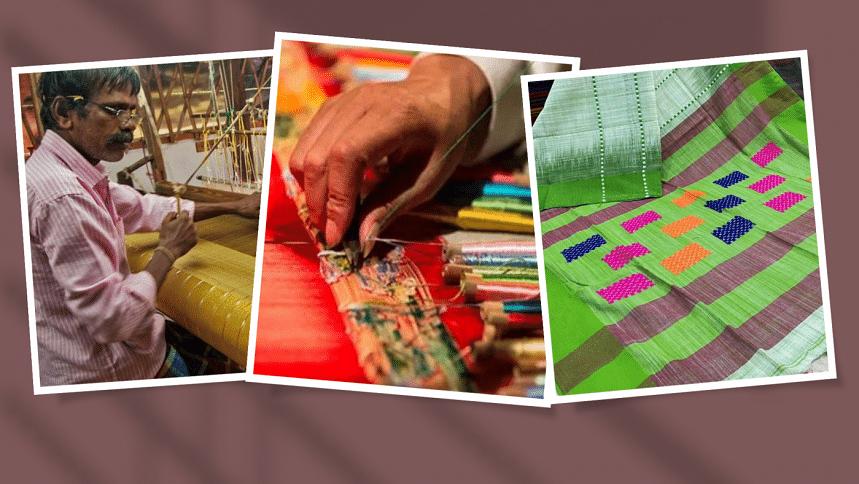Tangail saris: Caught in the crossfire of geographical indication

Originating from the Tangail district in Bangladesh, Tangail saris have been a part of our cultural heritage for ages. However, West Bengal has been awarded the geographical indication (GI) tag for Tangail saris — a decision that has stirred up a considerable amount of debate and concern. On 1 February, 2024, India's Ministry of Culture wrote in a post on Facebook, "The Tangail saree, originating from West Bengal, is a traditional handwoven masterpiece."
Chief Minister of West Bengal, Mamata Banerjee, similarly congratulated the artisans on X (formerly Twitter), writing, "Three handloom saree items of West Bengal, namely Tangail of Nadia and Purba Bardhaman, and Korial and Garad of Murshidabad and Birbhum, have been registered and recognised as GI products."
Sadly, discussions with industry insiders revealed a sense of surprise and disappointment over the GI tag's allocation to West Bengal. Upon contacting the Deputy General Manager (DGM) of the Bangladesh Handloom Board, Ratan Chandra Saha, told The Daily Star that they were unaware of the matter and a meeting would soon be held to address the issue.
An attempt to reach the Ministry of Culture, India was also taken via email and the official Facebook page. However, till the writing of this report, no response has been received.
Many within the industry, upon hearing the news, expressed their surprise and disappointment, highlighting a disconnect between the sari's origins and its newly assigned geographical indication.
Reputed designer, researcher, and President of the National Crafts Council of Bangladesh (NCCB), Chandra Shekhar Saha, remarked, "There is no doubt that Tangail district is situated in Bangladesh. So, we have a strong claim over Tangail saris. It is a matter of great regret that India has received the GI tag, but all is not lost yet and we can still get the GI tag."
"We need a proper publication on Tangail saris just like we have for Jamdani saris. Again, the GI tag is given to a country, not to a certain person or organisation. Therefore, it is the responsibility of our government to start the process of attaining the GI tag for Tangail saris."
Tangail saris, known for their unique handwoven techniques, designs, and motifs, have been traditionally produced in the Tangail district of Bangladesh. The artisans of Tangail have improved their craft over generations, preserving the traditional methods and contributing to the cultural identity of Tangail saris.
Criticising the accreditation to West Bengal, Raghunath Basak, who has been crafting Tangail saris for decades, said, "Initially, Tangail saris were regarded as taant saris. However, my ancestors moved from one place to another in search of a suitable climate to produce these saris. Eventually, they found the perfect weather in Tangail and thus, these taant saris came to be known as Tangail saris."
However, Basak questions how India can claim the GI tag for Tangail saris. He highlights, "In West Bengal, these taant saris are produced mainly in Nadia and Purba Bardhaman districts. So, they should regard them as saris of Nadia or Purba Bardhaman, not as Tangail saris."
The Basak community, integral to Bangladesh's Tangail sari weaving, migrated to India during the Partition. This move, according to Raghunath Basak, spread their textile craftsmanship traditions across borders.
SK Saifur Rahman, content consultant, Haal Fashion of Prothom Alo, informed, "Last month, I discussed with a Bangladesh Handloom Board senior official about India obtaining the GI tag for Tangail saris, a fact unknown to the board's chairman and the committee members responsible for the GI application. They admitted the application was delayed due to lack of time, leaving the file untouched for two months."
Munira Emdad, proprietor of Tangail Saree Kutir Ltd., expressed her discontent over the GI recognition. She commented, "India has registered the traditional Tangail sari as a geographical indication (GI) product of West Bengal on an international level, and hearing this news, I was deeply saddened and surprised at the same time. Weaving in Tangail has been going on for hundreds of years. It's surprising and bewildering how a product, geographically named after Tangail, gained recognition in a different country!"
The debate surrounding the geographical indication (GI) tag for Tangail saris underscores the importance of GI tags not only in protecting economic interests but also in preserving the cultural identities of communities.
For Bangladesh, securing a GI tag for Tangail saris would not only recognise the craftsmanship of its weavers, but also protect and celebrate a significant part of our cultural heritage. It is high time our government acknowledged this issue and took proper steps to safeguard the unique story and heritage of products like the Tangail sari.

 For all latest news, follow The Daily Star's Google News channel.
For all latest news, follow The Daily Star's Google News channel. 








Comments